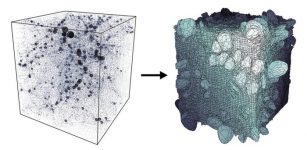NASA’s Perseverance Rover Begins Collecting Rock In Search Of Alien Life
Eddie Gonzales Jr. – MessageToEagle.com – The rover Perseverance continues to explore Jezero Crater, and it has begun drilling into the surface. NASA reports it is the first-ever digging into the Martian Planet by a robot.
Data sent to Earth by NASA’s Perseverance rover after its first attempt to collect a rock sample on Mars and seal it in a sample tube indicate that no rock was collected during the initial sampling activity.
 Perseverance’s Navigation Camera Image of First Borehole: The drill hole from Perseverance’s first sample-collection attempt can be seen, along with the shadow of the rover, in this image taken by one of the rover’s navigation cameras. Credits: NASA/JPL-Caltech.
Perseverance’s Navigation Camera Image of First Borehole: The drill hole from Perseverance’s first sample-collection attempt can be seen, along with the shadow of the rover, in this image taken by one of the rover’s navigation cameras. Credits: NASA/JPL-Caltech.
The rover carries 43 titanium sample tubes and during the drillings, it will be gathering samples of rock and regolith (broken rock and dust) for future analysis on Earth.
“While this is not the ‘hole-in-one’ we hoped for, there is always the risk with breaking new ground,” said Thomas Zurbuchen, associate administrator of NASA’s Science Mission Directorate in Washington. “I’m confident we have the right team working this, and we will persevere toward a solution to ensure future success.”
Perseverance’s Sampling and Caching System uses a hollow coring bit and a percussive drill at the end of its 7-foot-long (2-meter-long) robotic arm to extract samples. Telemetry from the rover indicates that during its first coring attempt, the drill and bit were engaged as planned, and post-coring, the sample tube was processed as intended.
“The sampling process is autonomous from beginning to end,” said Jessica Samuels, the surface mission manager for Perseverance at NASA’s Jet Propulsion Laboratory in Southern California. “One of the steps that occurs after placing a probe into the collection tube is to measure the volume of the sample. The probe did not encounter the expected resistance that would be there if a sample were inside the tube.”
The Perseverance mission is assembling a response team to analyze the data. One early step will be to use the WATSON (Wide Angle Topographic Sensor for Operations and eNgineering) imager – located at the end of the robotic arm – to take close-up pictures of the borehole. Once the team has a better understanding of what happened, it will be able to ascertain when to schedule the next sample collection attempt.
“The initial thinking is that the empty tube is more likely a result of the rock target not reacting the way we expected during coring, and less likely a hardware issue with the Sampling and Caching System,” said Jennifer Trosper, project manager for Perseverance at JPL. “Over the next few days, the team will be spending more time analyzing the data we have, and also acquiring some additional diagnostic data to support understanding the root cause for the empty tube.”
Previous NASA missions on Mars have also encountered surprising rock and regolith properties during sample collection and other activities. In 2008, the Phoenix mission sampled soil that was “sticky” and difficult to move into onboard science instruments, resulting in multiple tries before achieving success. Curiosity has drilled into rocks that turned out to be harder and more brittle than expected. Most recently, the heat probe on the InSight lander, known as the “mole,” was unable to penetrate the Martian surface as planned.
“I have been on every Mars rover mission since the beginning, and this planet is always teaching us what we don’t know about it,” said Trosper. “One thing I’ve found is, it’s not unusual to have complications during complex, first-time activities.”
Written by Eddie Gonzales Jr. MessageToEagle.com Staff










